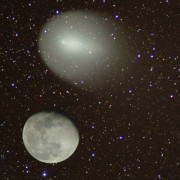Comet Holmes - a Media Non-event
03/29/08
On October 24, 2007, Comet 17PHolmes brightened dramatically by a factor of a million. Within 24 hours, it had gone from a small 17th magnitude comet to a magnitude of 2.5, easily visible with the naked eye. It wasn't finished its impressive display just yet though. Holmes kept expanding until by mid-November it had become the largest object in the solar system and had surpassed the Sun in volume. The diameter of the coma had grown from 28 thousand kilometres to 7 million km.
The diameter of Holmes' coma had grown by a factor of 250 and the volume had increased by a factor of 62 million to an impressive 180 quintillion (18 zeroes) cubic km. The volume is currently 5 times that of the sun. You might think that this remarkable behaviour would be big news, particularly among astronomers. A prominent Astronomy magazine recently published their top ten news stories of 2007. Surprisingly, this spectacular comet was not named as the top story. It didn't even finish in the top ten. In fact, the entire magazine completely ignored the comet. There was not even an editorial comment. Additionally, there was little if any newspaper or TV coverage. How could this be, you might wonder?
The standard model used to explain comets as dirty snowballs was concocted by Fred Whipple over fifty years ago. This theory has a very difficult time explaining Comet Holmes. After more than two months following the flare-up, the only explanations available on the internet are:
-
Scientists speculate that the comet has an unconventional nucleus which periodically exposes certain amounts of its icey core to the sun, causing the explosion.
-
The cause of the outburst is not definitely known. The huge cloud of gas and dust may have resulted from a collision with a meteoroid, or, more probably, from a build-up of gas inside the comet's nucleus which eventually broke through the surface.
-
There is growing evidence that some comets and asteroids may have a porous internal structure akin to, say, swiss cheese or a honeycomb. Suppose one of the chambers of the honeycomb suddenly collapsed, exposing many square kilometers of fresh cometary ice to sunlight for the first time. A flurry of sublimation would ensue with mega-jets of dusty gas emerging from the sinkhole to create a cloud around the comet much as we see now.
The common thread of each of these explanations is that they don't really say anything constructive. The explanations are merely scientists' way of shrugging their shoulders whilst maintaining their snowball theory and justifying their exorbitant salaries. None of them hold up to the slightest bit of scrutiny.
-
An explosion or collapse would be assymetrical, not the uniform, spherical envelope around the nucleus that is observed.
-
An explosion could be expected to produce an assortment of fragmentary sizes, not just the fine dust that is observed.
-
Typically, the duration of an explosion luminescence is less than a minute, not months. What explosion mechanism are they proposing that can luminate for months?
-
Dusty gas would quickly disperse away from the comet, not persisting in a cluster for over two months.
Each of the mainstream theories has the nucleus providing the additional material for the coma. A quick density calculation will now challenge this core belief. Dimensions for the nucleus of the comet before the flareup are not known so we will generously assume an initial diameter of 50 km. It's current nucleus is 3.6 km in diameter. This difference in size would have provided 500,000 cubic km of material.
The density of asteroids is typically 3 to 5 grams per cubic centimetre. The density of water is 1 gram per cubic centimetre. The density of the nucleus should be somewhere between these values. We will again be generous and assume 5 grams per cubic centimetre. This would mean that the nucleus ejected an astonishing 3 quadrillion tonnes (15 zeroes) of material. However, spreading this mass over the extent of the enlarged coma would only result in a density of less than 2 grams per cubic km inside the coma.
How can such a diffuse substance cause the brightness to increase by a factor of 1 million? How can it even be visible from so far away? Just what exactly is lighting this thing up? It couldn't possibly be sunlight reflecting from such rarefied material. Now consider that they are suggesting that a few cubic km of gas were released into the coma rather than the 50 cubic km of solid rock that was assumed in the calculations. Their argument becomes even more ludicrous.
As difficult as the flareup of Holmes is for the dirty exploding snowball theory, scientists have not even attempted to explain how an "unusual nucleus" could flare up thrice in just over a hundred years. Back in 1892, it flared up twice within two and a half months. This is not the only comet that has been larger than the sun. The Great Comet of 1811 also expanded dramatically and was also larger than the sun. Its diameter reached 2 million kilometres and the tail was 160 million km in length, see Atlas of the Solar System, Patrick Moore & Garry Hunt . Other comets have also flared up, but not to the same extent. Although flaring comets may not be a common event, it still happens nonetheless and comprehensive explanations should be required of any cometary theory.
Is a better explanation available for this apparently bizarre behaviour?
Wal Thornhill has repeatedly used the Electric Universe theory to successfully predict observations made by cometary missions that have stupefied mainstream astronomers at every turn. See his proven track record for both the Deep Impact and the Stardust missions.
A simple explanation for the comet using this electrical theory is that the coma and tail are the plasma sheath surrounding the nucleus and glowing in normal glow mode and the jets are electric arc discharges to the nucleus. The fine dust has been electrically machined off the surface of the comet by a process similar to the arc welding process that is commonly used by industry. See here for a more detailed examination of cometary theory. On October 24, the comet entered an area of a higher voltage differential which increased the extent of the visible discharge.
In a private email, Thornhill suggested that:
"Outbursts from comets at great distances from the Sun seem to be correlated with a sudden change in the solar 'wind' plasma environment due to a solar storm. The point about sudden comet outbursts is that we are dealing with a sudden, discontinuous process of plasma discharge - a switch from dark current mode to normal glow mode. It is a complex surface phenomenon that cannot be predicted. The best we can do is to say that the passage of a sudden change in the solar wind is the most likely time to see a flareup."
The sun had been electrically active in the days before the "explosion". Upon investigation of data from the ACE satellite, see this movie or this graph, Michael Mozina noticed that there was a large spike in the density of the solar wind on October 22 at 19:45, two days before the infamous flareup. This spike likely switched the comet into normal glow mode and allowed it to grow. Once in normal glow mode, the plasma coma does not require a sustained voltage to maintain that mode.
For other comments on Comet Holmes click here.
Scott Wall.
Permalink to this article.
Public comment may be made on this article on the
Thunderbolts Forum/Thunderblogs (free membership required).
For a highly-acclaimed 60-minute video introduction to the Electric Universe, see
Thunderbolts of the Gods on Google Video.
|

From
SpaceWeather.com Comet 17PHolmes on November 26 2007, and the moon photographed
on the same night with the same lens, as an inset for comparison. CREDIT: Jimmy Westlake,
Stagecoach, Colorado, USA.
[Click image for enlargement]
Guest's Archives
Chronological Archives
Archives by Author
Archives by Subject
Thunderblogs home
|




